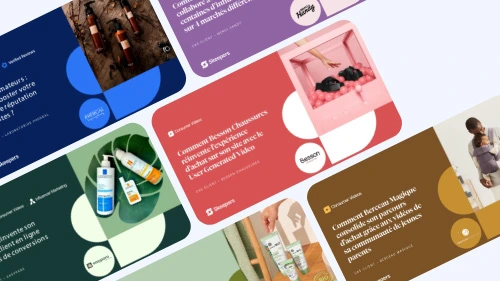AI has posed many questions to marketeers and creators alike. Is it taking over our jobs, our creativity, our content? It’s true that today AI-generated content is rapidly reshaping marketing and offering brands scalable and efficient ways to create personalized content. From product descriptions to social media posts, AI provides speed and volume that are...
AI has posed many questions to marketeers and creators alike. Is it taking over our jobs, our creativity, our content? It’s true that today AI-generated content is rapidly reshaping marketing and offering brands scalable and efficient ways to create personalized content. From product descriptions to social media posts, AI provides speed and volume that are hard to match at a human level.
However, an undeniable fact is that user-generated content (UGC)—created by real people—remains invaluable for its authenticity and ability to build trust. UGC offers genuine experiences that foster deeper connections with audiences and serve as powerful social proof.
This raises a key question: Can AI-generated content replace UGC, or do they fulfill different roles in modern marketing? Let’s explore the dynamics between the two.
What is AI-Generated Content?

AI-generated content refers to any form of digital content created by artificial intelligence. Using machine learning and algorithms, AI systems analyze data, identify patterns, and generate content based on the information provided. These systems are capable of automating tasks like writing product descriptions, generating social media posts, or even producing blog articles with minimal human input. AI tools can also handle customer interactions through chatbots, providing instant responses to frequently asked questions.
In marketing, AI-generated content is used to streamline processes and improve efficiency. For example, brands can use AI to automatically create personalized email campaigns, craft SEO-friendly product descriptions, or schedule social media updates. The ability to generate large volumes of content quickly allows brands to scale their marketing efforts without sacrificing consistency.
The Unique Value of User-Generated Content

UGC is any form of content—such as reviews, photos, videos, and social media posts—created and shared by real customers rather than the brand itself. UGC has become a cornerstone of modern marketing. It provides a level of authenticity that cannot be replicated by traditional advertising or AI-generated content.
One of the key strengths of UGC is its ability to build trust. When potential customers see content created by real users, they view it as genuine and unbiased, making them more likely to trust the product or service being promoted. UGC acts as social proof, validating the experiences of others and reassuring new customers that the brand delivers on its promises.
At its core, UGC evokes emotional connections and offers social proof—elements that are crucial in today’s trust-driven marketplace. While AI can automate and scale content, it cannot replicate the genuine experiences and personal endorsements that come from real customers. The authenticity and emotional depth that UGC provides are invaluable in building long-term brand loyalty.
Key Differences Between AI-Generated and User-Generated Content
While both AI-generated content and user-generated content (UGC) play important roles in marketing, their core differences lie in authenticity, engagement, and trust.
Authenticity is where UGC has a clear advantage. AI-generated content, while efficient and scalable, lacks the real human experiences that consumers value. UGC, on the other hand, comes directly from real people who have used the product or service. This personal touch brings a level of authenticity that AI simply cannot replicate.
Consumers can tell when content is crafted by AI, which can sometimes feel impersonal or mechanical, while UGC is rooted in genuine, lived experiences.
In terms of engagement, consumers interact with UGC and AI-generated content differently. UGC tends to foster more organic engagement because it feels relatable. People are more likely to comment, like, or share content created by someone like them, reinforcing the sense of community and participation.
AI-generated content, although useful in driving efficiency, may not inspire the same level of interaction because it lacks that personal connection.
The trust factor is another key difference. UGC carries the human touch—real stories, photos, and testimonials—that make it more trustworthy. Consumers place a high value on recommendations and feedback from their peers, as these are seen as unbiased and authentic.
AI-generated content, while informative, doesn’t evoke the same level of trust because it is seen as automated and detached from real user experiences. In a market where trust is crucial, UGC still holds a unique power to persuade.
The Role of AI in Enhancing UGC, Not Replacing It

The good news is that AI’s role in marketing doesn’t need to compete with user-generated content (UGC). Rather, it can enhance and amplify UGC in ways that improve efficiency and effectiveness. By automating processes such as content moderation, curation, and analysis, AI can make managing UGC easier while maintaining its authenticity.
One of the most significant ways AI supports UGC is through content moderation. As brands encourage customers to create and share their own content, managing the sheer volume of submissions can be overwhelming. AI-powered tools can automatically filter out inappropriate or irrelevant content, ensuring that only high-quality UGC is showcased. This automation allows brands to focus more on the strategic use of UGC while maintaining a consistent standard.
AI also helps with content curation, identifying the most relevant UGC for different marketing channels. By analyzing engagement metrics and patterns, AI can determine which user-generated photos, videos, or reviews are likely to resonate best with a particular audience. This targeted approach maximizes the impact of UGC without requiring manual selection.
Another area where AI excels is in data analysis. AI tools can analyze UGC to uncover key insights, such as sentiment trends, customer preferences, and product feedback. These insights help brands fine-tune their marketing strategies while leveraging authentic UGC to connect more deeply with their audience.
The synergy between AI and UGC allows brands to scale their efforts without losing the human touch. AI can amplify the reach and impact of UGC by streamlining workflows. What it cannot do is replace the real experiences and authenticity that UGC provides. For example, companies like Airbnb use AI to analyze UGC (such as guest reviews) to surface the most relevant and inspiring content in their marketing materials, while still maintaining the authenticity of real customer experiences.
In this way, AI and UGC work together to create more efficient, impactful marketing strategies. AI enhances the power of UGC. It ensures that the right content reaches the right audience.
Conclusion
User-generated content will remain a cornerstone of marketing due to its authenticity, trust-building, and emotional connection with consumers. While AI offers efficiency and scalability, it cannot replace the genuine, human experiences that UGC provides. The key for brands is to strike a balance—leveraging AI tools to enhance and amplify UGC while preserving its authenticity. By combining the strengths of both, brands can create more impactful, relatable marketing strategies.












